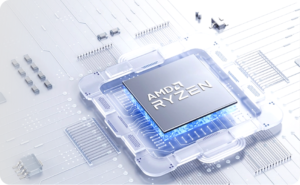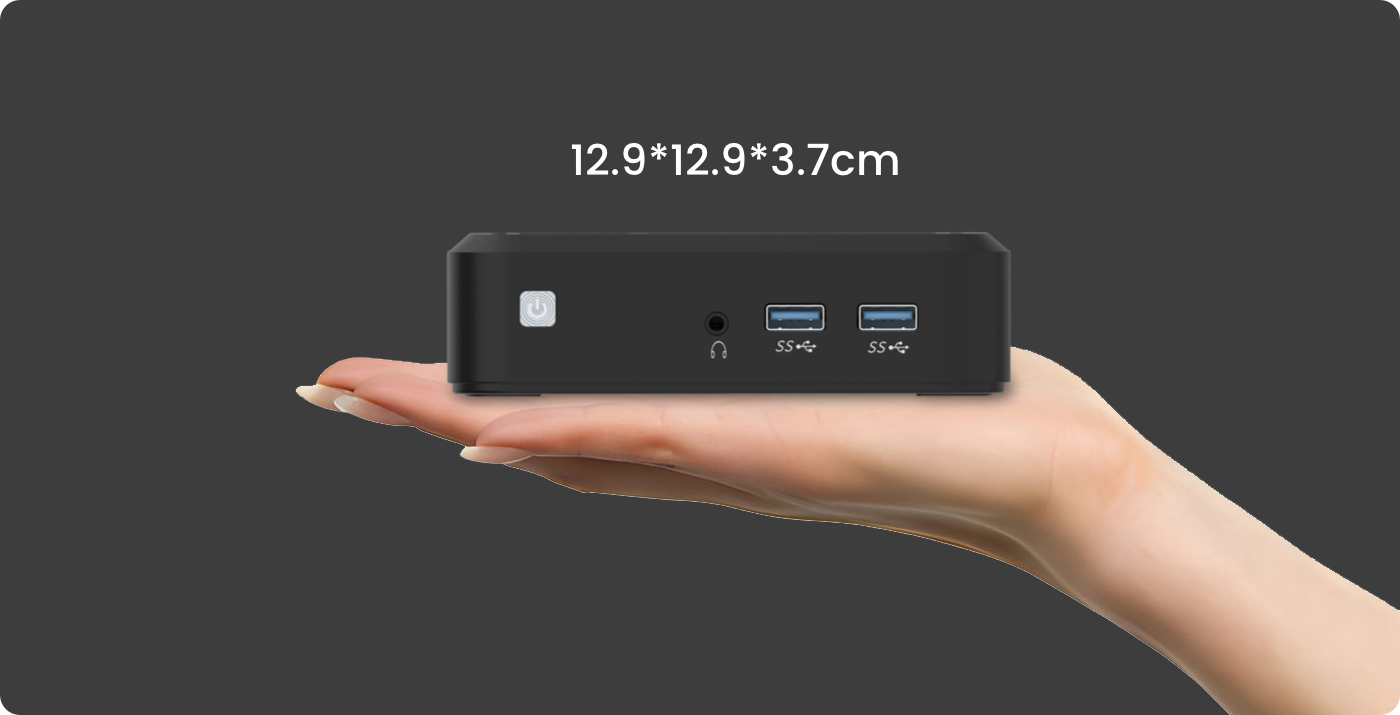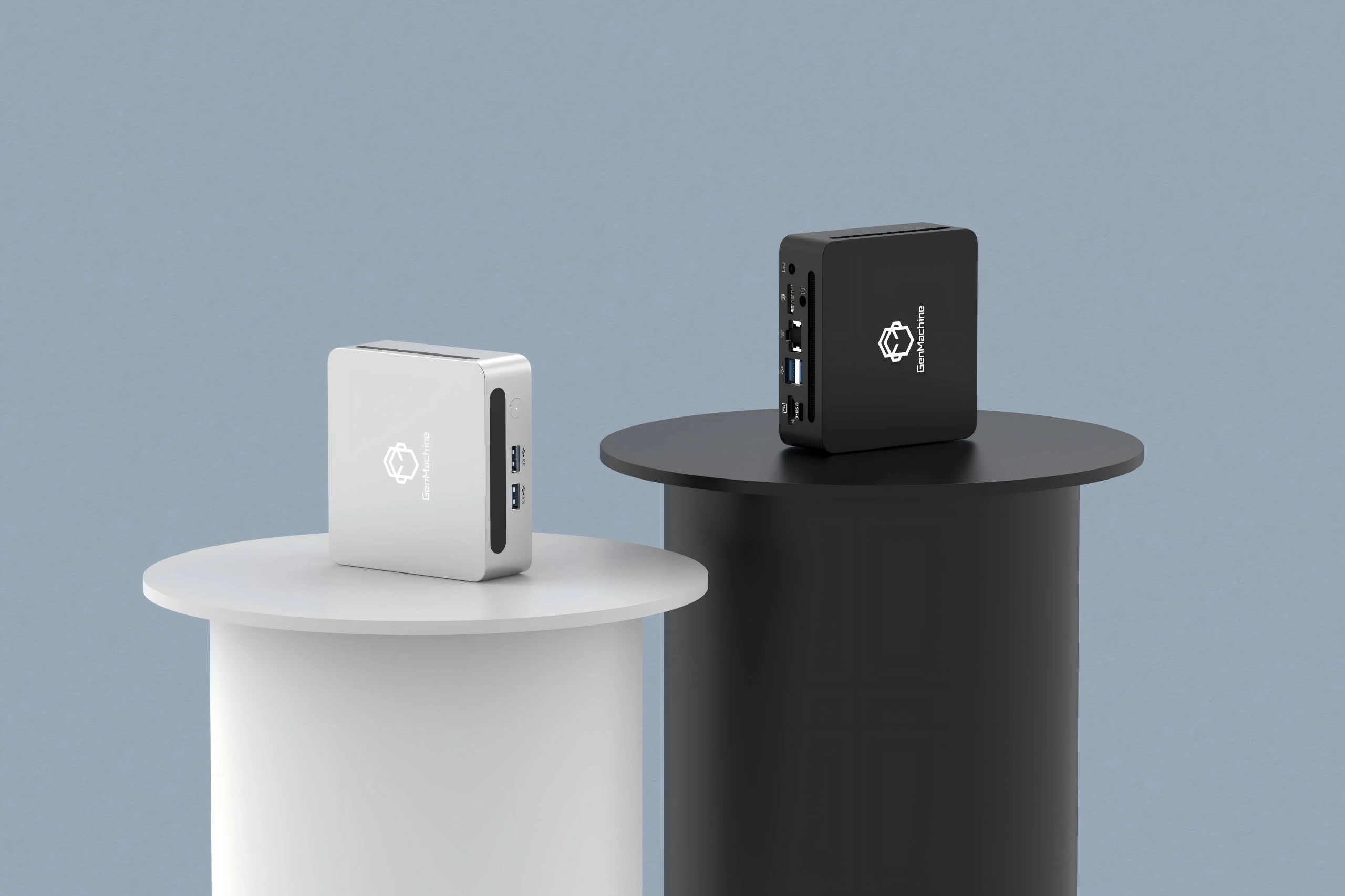In the wave of digital technology, mini PCs have become popular among buyers due to their small, compact appearance and effective performance. From home offices to creative design, from education and training to entertainment and leisure, the Ryzen mini PC quietly changes work and free time with its many uses. In this change, processor upgrades as the main force behind Mini PC development are redefining the heat limits of Mini PCs with their great work and energy control, letting them show lots of power in little space.
Table of Contents
Ⅰ. The Development History of Amd Ryzen Mini PC Processors: From Low Power Consumption to High Performance
The early AMD Ryzen mini PC processors were mostly designs of low power, such as the Intel Atom series and AMD APU series. In terms of power consumption, it can meet basic office applications, such as processing documents and browsing the Internet. It can provide the user with light and practical solutions for computing. With the evolution of user demand and more complex application scenarios, different requirements have been set for the performance of Mini PCs.
Therefore, technological innovation has been undertaken by processor manufacturers in the sector of AMD Ryzen mini PC processors to deliver faster performance as per the rising demand in the market. Take the example of AMD Ryzen series processors, which use the state-of-the-art Zen architecture optimized in terms of instruction sets, cache hierarchies, and branch prediction. Large increases in IPC have been delivered gen-over-gen with the Zen-based processors.  From the original Ryzen processors first introduced to the market, the multi-core performance has massively risen with the final iteration of the Ryzen 7000 series processors. This upgrade in the single-core performance results in a more responsive application on the high-load single-threaded tasks; lag would be experienced on the application software’s launch and Adobe operation in the previous design software.
From the original Ryzen processors first introduced to the market, the multi-core performance has massively risen with the final iteration of the Ryzen 7000 series processors. This upgrade in the single-core performance results in a more responsive application on the high-load single-threaded tasks; lag would be experienced on the application software’s launch and Adobe operation in the previous design software.
With this major upgrade in multi-core performance, now multi-tasking, like video editing with other resource-demanding applications running simultaneously, has become easy on these Mini PCs. This has greatly broadened the application scope. This will not only make Mini PCs easily able to undertake the everyday office work but to take that to another level where it can outperform in challenging fields such as creative design and video editing. Hence, it will be able to provide strong computational support for the professional users and workers creatives. This will further catalyze the transformation of Mini PCs into high-performance computing platforms; the other offer will also help meet the market demand for different application scenarios.
Ⅱ. Process Technology and Microarchitecture
AMD Ryzen chips shine in the AMD Ryzen mini PC market. They have excellent production and creative design that delivers sizzling performance and also energy efficiency. Take the Ryzen 7 8845HS as an example. It uses an advanced 8-nm process, shrinking transistor size and fitting more transistors in the same area. This boosts performance and cuts power use.
Based on the optimized Zen 3 architecture, the Ryzen 7 8845HS has 8 cores and 16 threads. Its base frequency is 3.2GHz, and it can boost up to 4.7GHz. This makes it powerful for multitasking and complex computations, ensuring smooth Mini PC operation. Plus, AMD’s Precision Boost 2 and Precision Boost Overdrive technologies adjust frequencies based on workload, further enhancing performance and energy efficiency.
1. The field of creative design
the Mini PCs with AMD Ryzen processors are pretty good. Adobe Photoshop and Premiere Pro and 3D modeling quite happily coexist with them, as they don’t break a sweat in handling design rendering. That multi-core power lets a good number of professional applications be run by designers at once so that they can get their work done quickly and without lag. For starters, Ryzen’s multi-threading is great for speeding up processes like high-res image processing and 4K video editing. That’s real-time previewing and rendering of complex effects. Plus, the support for PCIe 4.0 does wonders for increasing the speed of both the storage and the graphics cards which do a lot of data transfer and processing of the graphics. In a nutshell, the AMD Ryzen processors make Mini PCs very advanced devices for creative design work, which is a must for any designer. As the performance of the processors gets enhanced, there arises a notable issue related to cooling in the development of AMD Ryzen mini PC with respect to accommodating high-performance processors in the Mini PCs stably; therefore, the cooling technology for Mini PCs has advanced tremendously.
2. Amd Ryzen Mini PC Heat Sink Technology
It utilizes the latent heat of vaporization to quickly transfer heat from the heat source to the heat sink. In GenMachine’s mini PC, the surface area of the CPU and GPU components accounts for approximately 90% of the liquid cooling vapor chamber.  These vapor chambers can quickly transfer the heat generated by the processor to the heat sink fins, which then dissipate the heat through natural convection or fans.
These vapor chambers can quickly transfer the heat generated by the processor to the heat sink fins, which then dissipate the heat through natural convection or fans.
Consider the GenMachine Yi series Amd Ryzen mini PC with the R7 – 7840HS (54W TDP). In the Cinebench R23 test, the temperature is 15°C lower when tested with a vapor chamber cooling solution than when using the set point conventional solution. This leads to better cooling performance, thereby ensuring the stable operation of processors under high load. Liquid metal cooling represents a very high-end Mini PC facilitated by a thermal conductivity of as much as 73W/m·K in contrast to merely 5W/m·K within traditional thermal grease allowing much better performance by way of transferring heat from the chip to the heat sink.
It turns out that such an amd ryzen mini PC with liquid metal cooling technology installed is beneficial to the processor in the way; that during practical applications, it successfully lowered the peak temperature of the processor. With R7-8845HS processors, Mini PCs registered an 18°C fall in GPU peak temperature as opposed to traditional solutions, therefore best performance even under prolonged high-load operation.
Ⅲ. Processor Development Trends: Future Prospects for Small Computer Technology and Analysis of Core Technologies
1. Continued Performance Gain and Less Power Consumption
Further miniaturization of semiconductor technologies into the small nanoscale will prevail over the years to come, with processes likely ranging to 3nm or even less. This would enhance processor performance and energy efficiency further while curbing down power intake and the associated heating up of devices. With each successive process node, transistors get smaller, and electron migration gets faster. This effectively translates to higher computational speeds at similar power levels or to lower energy use at the same level of performance, which is quite a boon for Mini PCs that need to be small, portable, and high-performing.To boost processor performance and energy efficiency, architectural design is constantly optimized. 、Future processors will focus more on multi-core, multi-threaded designs, instruction set optimizations, and better cache management. This means better performance with less power use and heat.
For example, advanced branch prediction algorithms can reduce processor idle time during instruction execution. Larger caches and smarter cache coherence protocols can also cut down the number of times the processor accesses memory. This leads to lower power consumption and latency. These improvements will allow Mini PCs to deliver more powerful computing capabilities, even in small spaces.
Heterogeneous computing means combining different processor cores like CPUs, GPUs, and AI accelerators. This improves overall performance. It lets processors use resources better for different tasks. For example, GPUs can do most of the work for graphics rendering while CPUs handle other tasks. This makes Mini PCs better at graphics. Adding AI accelerators also speeds up machine learning. This makes Mini PCs better for AI tasks. With these changes, future Mini PCs will be ready for many uses, like office work, fun, or professional tasks.
2. Synergistic Optimization of Amd Ryzen Mini PC Thermal Management and Expandability
Amd Ryzen mini PC development needs both expandability and thermal management to advance together. Users want more storage and device connections, so mini PCs need strong expandability. But as hardware gets better, heat becomes a bigger problem. This limits AMD Ryzen mini PC development. So, designers must find a way to improve both heat control and expandability in the small space of mini PCs.
In thermal management, new materials like graphene, carbon nanotubes, and phase-change materials are replacing traditional ones. These new materials conduct heat well, are mechanically strong, and can absorb or release heat as temperatures change. They improve thermal management efficiency and help make mini PCs smaller.
In thermal management structural innovation, heat pipes, heat spreaders, vapor chambers, and other new thermal management structures are widely adopted. Combined with more efficient fan blade designs, more rational airflow channel layouts, and quieter bearing technologies, these innovations further improve thermal management performance while reducing noise and power consumption.
Moreover, through the synergistic design of heat dissipation materials and structures, such as applying graphene coatings to the surfaces of heat pipes, and optimizing heat dissipation systems and internal layouts, such as reasonably pairing heat dissipation systems with power supplies, storage, and other components and optimizing airflow paths to reduce heat buildup, it is possible to maximize heat dissipation performance while ensuring expandability. This achieves efficient heat dissipation in limited space, ensuring the stable operation of Mini PCs.
How does Mini pc achieve efficient heat dissipation and silent operation?
Ⅳ. Applications of Heat Dissipation Technology in Different Scenarios
Heat dissipation technology plays a crucial role in mini desktop PC application scenarios. Its efficient thermal management capabilities not only ensure device stability under high-load operation but also significantly enhance user experience. The following provides detailed explanations based on specific technologies and application scenarios:
1. Edge Computing Devices
In factory and warehouse settings, Mini PCs are tasked with handling vast amounts of data generated by sensors and cameras. Efficient thermal management technologies, such as solid-state active cooling, are crucial in ensuring the stability of Mini PCs under high-load conditions. These technologies prevent overheating-induced computational delays or interruptions, enabling real-time data processing and local decision-making.
Sensors measure various parameters, including temperature, humidity, and pressure. Cameras provide visual info to monitor the work area. Mini PCs with good cooling systems can quickly analyze this data. They can spot problems and fix them fast. This boosts efficiency and safety. In a warehouse, Mini PCs can use real-time data to check inventory and equipment. This helps with automated inventory and maintenance. Solid-state cooling keeps the Mini PCs running smoothly under heavy load. This ensures reliable data processing and decision-making. Overall, good thermal management helps Mini PCs perform well in factories and warehouses. They can meet the needs of modern industry.
2. High-Performance Digital Signage and Interactive Kiosks
In places like shopping malls and airports, mini desktop PCs run high-resolution displays and complex content. Thermal management technology keeps the devices cool, reducing failures and fan noise. This gives users a smooth and quiet experience.
3. Cloud Gaming Terminals and Professional Audio Workstations

In cloud gaming and pro audio production, mini desktop PC handle intense graphics and audio data. Smart temperature control and efficient thermal design stop overheating, preventing frame drops and audio distortion. This ensures smooth gaming and accurate audio production.
4. Portable High-Performance Office Workstations
For engineers and designers who frequently travel, the AMD Ryzen mini PC’s compact size and lightweight design make it an ideal choice. Cooling technology ensures the device remains stable while running high-load tasks such as CAD design and video editing while minimizing performance degradation caused by inadequate cooling.
5. AIoT Smart Hub
In AIoT scenarios, mini PCs need to run AI algorithms continuously and connect to multiple smart devices. Thermal management technology optimizes internal heat circulation to extend device lifespan while reducing energy consumption, providing reliable support for intelligent management and data analysis.
Ⅴ. Conclusion
Processor upgrades, particularly the emergence of cost-effective platforms such as AMD Ryzen, have driven improvements in AMD Ryzen mini PC performance. This has been a game-changer, breaking through the limitations of early thermal management technologies. This is the primary driving force behind the development of mini PCs. The results so far indicate that mini computers have achieved significant performance improvements from the emergence of these new-generation processors, especially AMD Ryzen. Optimizations in thermal management materials, structural optimization, improved heat dissipation design, and overall thermal design have all significantly enhanced thermal management performance. GenMachine’s Zhi series mini desktop PC adopts advanced heat dissipation technologies, such as heat spreaders and liquid metal heat dissipation technology, ensuring excellent heat dissipation performance even with enhanced scalability. While these devices may have started as rudimentary devices with volatile components, mini-computers have evolved into the future of compact smart devices, redefining the concept of “cool” while enabling silent operation.





